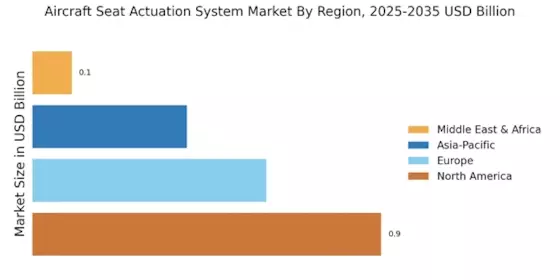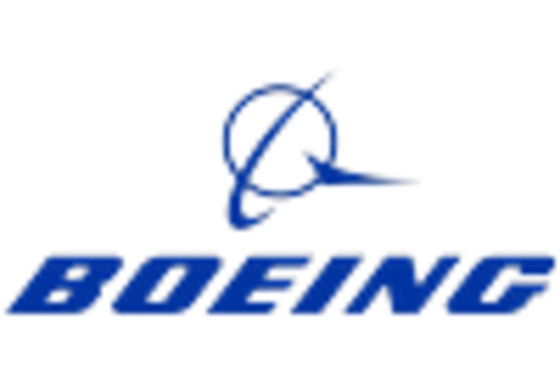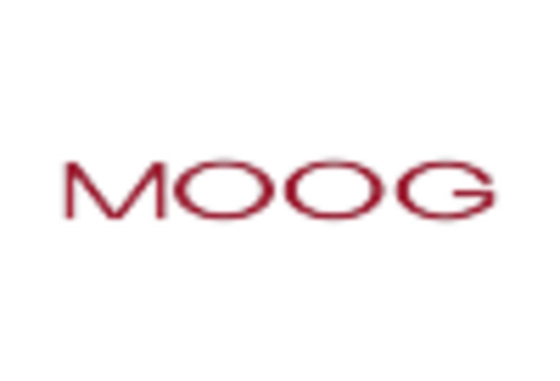Growth of the Aviation Sector
The Aircraft Seat Actuation System Market is poised for growth, driven by the overall expansion of the aviation sector. With an increase in air travel demand, airlines are investing in fleet upgrades and new aircraft, which necessitates the incorporation of modern actuation systems. Market data indicates that the commercial aviation sector is projected to grow at a compound annual growth rate (CAGR) of over 4% in the coming years. This growth is likely to stimulate demand for advanced seat actuation systems that enhance passenger experience and operational efficiency. As airlines seek to modernize their fleets, the Aircraft Seat Actuation System Market is expected to benefit from this upward trend, leading to increased investments in innovative actuation technologies.
Regulatory Compliance and Safety Standards
The Aircraft Seat Actuation System Market is significantly influenced by stringent regulatory compliance and safety standards imposed by aviation authorities. These regulations necessitate the incorporation of advanced actuation systems that meet safety requirements, ensuring that seats can withstand various forces during turbulence and emergency situations. The market is witnessing a shift towards systems that not only comply with existing regulations but also anticipate future safety standards. Data suggests that the market for safety-compliant actuation systems is projected to grow, driven by the need for enhanced passenger safety. As airlines prioritize compliance, the demand for innovative actuation solutions that align with regulatory frameworks is expected to increase, thereby shaping the Aircraft Seat Actuation System Market.
Increasing Demand for Comfort and Ergonomics
The Aircraft Seat Actuation System Market is experiencing a notable surge in demand for enhanced passenger comfort and ergonomic seating solutions. Airlines are increasingly recognizing that passenger satisfaction is directly linked to comfort levels during flights. As a result, there is a growing emphasis on the development of advanced actuation systems that allow for adjustable seating configurations. This trend is supported by data indicating that airlines investing in passenger comfort can see a rise in customer loyalty and repeat business. The integration of innovative actuation technologies, such as electric and pneumatic systems, is becoming commonplace, allowing for more versatile seating arrangements. Consequently, this driver is likely to propel the Aircraft Seat Actuation System Market forward, as airlines strive to differentiate themselves in a competitive landscape.
Focus on Weight Reduction and Fuel Efficiency
The Aircraft Seat Actuation System Market is increasingly influenced by the aviation sector's focus on weight reduction and fuel efficiency. Airlines are under constant pressure to minimize operational costs, and reducing the weight of aircraft is a critical strategy in achieving this goal. Advanced actuation systems that are lightweight yet durable are becoming essential components in modern aircraft design. Market analysis suggests that lightweight materials and innovative actuation technologies can lead to significant fuel savings, which is a key consideration for airlines. As the industry continues to prioritize sustainability and cost-effectiveness, the demand for efficient actuation systems is expected to rise, thereby impacting the Aircraft Seat Actuation System Market positively.
Technological Innovations in Actuation Systems
The Aircraft Seat Actuation System Market is being transformed by rapid technological innovations that enhance the functionality and efficiency of actuation systems. Developments in electric actuation technology, for instance, are enabling more precise control and energy efficiency, which is becoming increasingly important in the aviation sector. The integration of smart technologies, such as sensors and automation, is also gaining traction, allowing for real-time adjustments to seating configurations based on passenger needs. This trend is supported by market data indicating that the adoption of advanced actuation technologies is expected to rise significantly, as airlines look to improve operational efficiency and passenger comfort. Consequently, these technological advancements are likely to play a pivotal role in shaping the Aircraft Seat Actuation System Market.


















Leave a Comment